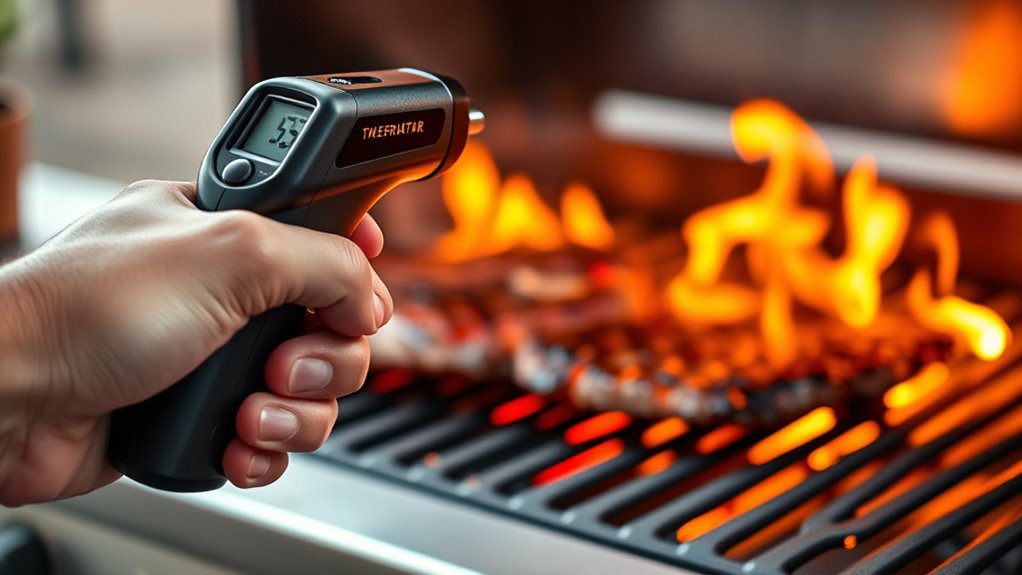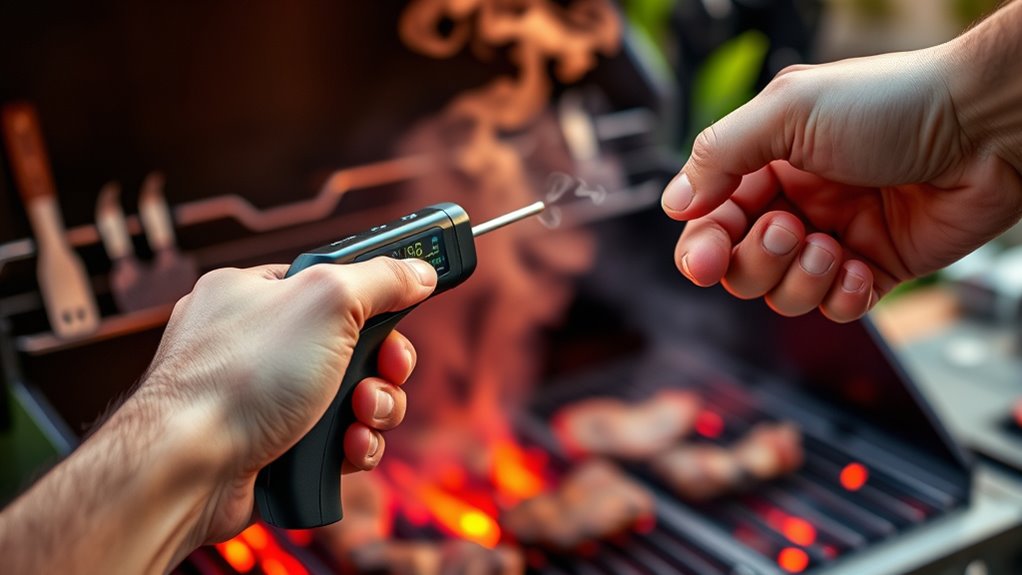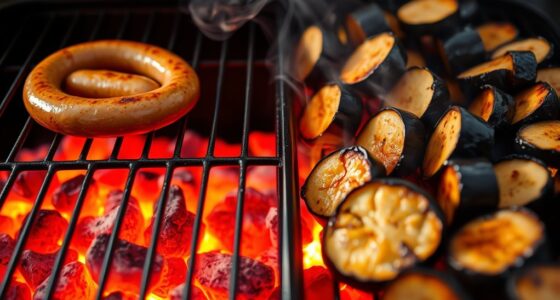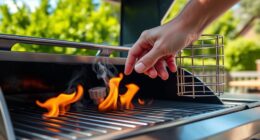Using infrared thermometers for grilling precision allows you to quickly check surface temperatures from a distance, giving you better control over hot spots and cold zones. With instant, accurate readings, you can adjust vents or food placement to guarantee even cooking. This tool helps you prevent uneven results and achieve perfect doneness every time. Keep exploring to find out how infrared thermometers can become your go-to grilling essential.
Key Takeaways
- Point the infrared thermometer at different grill surface areas to identify hot spots and cold spots for even cooking.
- Use quick temperature readings to adjust vents or food placement, ensuring consistent heat across the grill.
- Regularly monitor surface temperatures during grilling to maintain optimal heat levels and prevent overcooking.
- Measure multiple zones simultaneously to understand heat distribution and improve overall grilling control.
- Use the thermometer to confirm food reaches safe internal temperatures, enhancing both safety and quality.

When it comes to grilling, achieving the perfect cook depends on accurate temperature measurement. Using an infrared thermometer can significantly improve your grilling precision, especially when it comes to monitoring your cooking surface. Unlike traditional thermometers that require contact, infrared thermometers let you quickly gauge the temperature of your grill’s surface from a distance. This instant feedback allows you to make real-time adjustments, ensuring your food cooks evenly and avoids burning or undercooking.
Using an infrared thermometer ensures quick, accurate grill surface readings for perfect, evenly cooked results.
One of the key advantages of infrared thermometers is their ability to measure temperature with high accuracy across the cooking surface. When you point the device at the grill, it captures the infrared radiation emitted by the surface, providing a precise temperature reading in seconds. This rapid measurement is invaluable when you’re trying to maintain a consistent heat zone or when you’re working with multiple heat levels on different parts of your grill. It’s especially helpful for checking hot spots or cold spots that can affect cooking quality. By knowing the exact temperature of your cooking surface, you can better control the heat, which leads to better results and less guesswork.
The importance of temperature accuracy cannot be overstated. If your grill’s surface is uneven or if the temperature varies across different areas, your food may cook unevenly. An infrared thermometer helps you identify these variations quickly. For example, if one side of your grill is significantly hotter, you can move food accordingly or adjust the vents to balance the heat. This way, you prevent overcooking on one side and undercooking on the other, ensuring your food reaches its ideal internal temperature with perfect texture and flavor. Additionally, understanding thermal radiation helps you better interpret the temperature readings for more precise control.
Another benefit of using infrared thermometers is their versatility. They work well with all types of grills, whether gas, charcoal, or electric. Plus, they’re simple to operate: point, click, and read. This ease of use makes them an essential tool for both beginner and seasoned grillers who want to enhance their cooking precision. By regularly checking the temperature accuracy of your cooking surface, you can fine-tune your grilling technique, avoid surprises, and consistently produce delicious results.
Frequently Asked Questions
Can Infrared Thermometers Measure Internal Food Temperature Accurately?
Infrared thermometers can’t measure internal food temperature accurately. They only assess surface temperature, so you won’t get an exact internal temperature reading. For precise results, use a probe thermometer designed for internal temperature measurement. Infrared accuracy is great for checking surface heat or grill temperature but not for determining the doneness of your food. Always rely on a probe thermometer for safe, accurate internal temperature readings.
What Is the Ideal Distance to Hold an Infrared Thermometer From the Grill?
You should hold the infrared thermometer about 1 to 2 inches from the grill surface for ideal distance accuracy. This placement ensures precise temperature readings without interference from ambient air or heat radiation. Keep the thermometer steady and aim it directly at the spot you want to measure. Proper thermometer placement helps you get consistent, reliable results, so you can monitor your grill’s temperature accurately and cook your food to perfection.
How Do Weather Conditions Affect Infrared Thermometer Readings?
Weather conditions can dramatically affect your infrared thermometer readings, like a hurricane in a teacup. High ambient temperatures can cause overestimations, while cold weather leads to underestimations. Wind influence is especially tricky—it cools the surface rapidly, giving false low readings. Always account for ambient temperature and shield the thermometer from wind to get accurate grill surface temps, ensuring your food cooks perfectly every time.
Are Infrared Thermometers Safe to Use Around Open Flames?
Yes, infrared thermometers are safe to use around open flames if you follow flame safety guidelines. Keep the thermometer away from direct contact with flames and avoid pointing it directly at the fire to prevent damage. Proper thermometer placement is essential; aim it at the grill surface from a safe distance, ensuring you don’t compromise safety or accuracy. Always handle with care to avoid accidents.
How Often Should I Calibrate My Infrared Thermometer for Grilling?
Imagine your infrared thermometer as a trusted guide, helping you achieve perfect grill marks. To keep thermometer accuracy sharp, calibrate it at least once a year, or more often if you notice inconsistent readings. Regular calibration guarantees your temperature readings stay precise, preventing undercooked or overcooked food. Think of it as tuning your tool so every grill session hits the mark, making your barbecue consistently delicious.
Conclusion
Think of infrared thermometers as your grilling compass, guiding you to perfect doneness every time. Just like a lighthouse steers ships safely to shore, these tools help you navigate the heat with precision. By using an infrared thermometer, you’ll master your grill like a seasoned chef, ensuring juicy, flavorful results. Embrace this technology, and watch your grilling skills soar, turning every cookout into a sizzling success.








